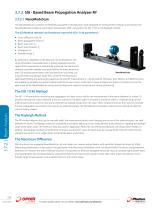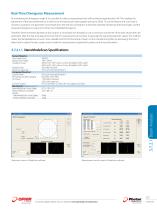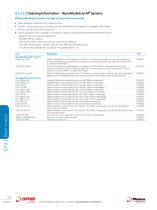
Catalog excerpts

3.7.2 Slit - Based Beam Propagation Analyzer M2 3.7.2.1 NanoModeScan The NanoModeScan combines the flexibility and speed of the NanoScan with dedicated M2 measurement hardware and software. The NanoModeScan provides an automated measurement of M2 using either the ISO 11146 or the Rayleigh method. The ISO Method software and hardware report the ISO 11146 parameters: Times diffraction limit: M2 Beam propagation factor: K Beam waist size: d0 Beam waist location: Z0 Divergence: θ Rayleigh range: Zr By adding the capabilities of the NanoScan to the ModeScan, the range of possible measurable lasers is greatly expanded and the speed of the measurements dramatically improved. The NanoScan’s software controlled variable scan speed allows the measurement of NanoModeScan both CW and kHz pulsed lasers with any NanoScan scan head, covering the entire wavelength range from UV to FIR. The NanoScan’s rapid beam finding and autoranging speed up the total M2 measurement to ~20 seconds for CW lasers. Both 200mm and 400mm lenses are available to generate the proper artificial waist for the laser source under test. For ease of alignment, there is an entrance iris on the optical axis of the NanoModeScan and a precision alignment stage for horizontal and vertical positioning. The ISO 11146 method for measuring the propagation of a laser source calls for the measurement of the beam diameter for at least 10 positions through the waist created by a test lens inserted in the beam path. Five locations should be within ±1 Rayleigh range of the artificial waist and at least five more points beyond two Rayleigh ranges from this waist. These measurements are then used to compute the laser propagation parameters. Once points are selected properly, the ISO Method is the fastest measurement method and best for volume testing of lasers. The Rayleigh Method The ISO method requires the user to manually select the measurement points, and changing one or two of the selected points can yield different M2 values. The Rayleigh method is completely automated, selecting its own measurement points based on mapping the Rayleigh range of the beam waist. This method is fully discussed in Application Note 230, Fast M2(k-factor) Measures with Photon Beam Profilers. In addition, the Rayleigh method can yield more consistent results for M2 values for lasers that are not exactly like those for which the ISO standard was written, such as fiber lasers, lensed diode lasers, and VCSELs. The NanoScan Difference With the NanoScan-equipped NanoModeScan, all scan heads can measure pulsed beams with repetition frequencies down to 10kHz. Measuring pulsed beams in discussed in the application note Measuring Pulsed Beams with a Slit-Based Profiler. The silicon and germanium detectors will measure less than a milliwatt of power. The pyroelectric detector-equipped NanoScan head can analyze higher power lasers at all wavelengths. The increased dynamic range of the NanoScan enhances the signal to noise ratio of the system and allows a much broader range of laser powers to be analyzed with one instrument setup. For latest updates please visit our website: www.ophirop
Open the catalog to page 1
Real-Time Divergence Measurement By monitoring the divergence angle 6, it is possible to make a measurement that will be directly proportional to M2.This enables the adjustment of the laser performance in real time at the NanoScan's rapid update rate (up to 20Hz).To use this feature, the scan head is moved to a position one geometric focal length from the test lens. Divergence is the beam diameter divided by the focal length, and the measured divergence is egual to M times the embedded divergence. Therefore when the beam diameter at this location is minimized, the divergence is at its...
Open the catalog to page 2
3.7.2.1.2 Ordering Information - NanoModeScan M² Systems All NanoModeScan Systems include (unless otherwise noted): High-resolution scanhead with rotation mount Two BK 7 lenses and mounts. Standard are 200 and 400mm focal length VIS coated for 430–700nm (not for use with Germanium detector) Choice of optional lens coatings. If choosing an optional coating the two standard VIS lenses will be replaced with one optional coating lens - NIR Near IR: 650–1000nm - LIR Long IR: 1000–1550nm (not for use with Silicon detector) - VLIR: Very long infrared >1550nm. (for use with NMS-NS2s-Pyro/9/5 only)...
Open the catalog to page 3All Ophir Optronics catalogs and technical brochures
-
SP932U
1 Pages
-
ConoPoint-3
2 Pages
-
nova catalog
2 Pages
-
nova ii catalog
2 Pages
-
vega catalog
2 Pages
-
BeamWatchAM
2 Pages
-
StarBright
2 Pages
-
680274
1 Pages
-
P920 Beam Profiling Camera
1 Pages
-
L2000W-PF-120
1 Pages
-
L40(250)A-BB-50
1 Pages
-
IS1.5-VIS-FPD-800
1 Pages
-
Optimet Industrial Catalog 2017
34 Pages
-
Energy Sensors Accessories
1 Pages
-
StarLite
2 Pages
-
Power Meters & Interfaces
1 Pages
-
Power Meters Vega
2 Pages
-
Goniometric Radiometers
3 Pages
-
1780 Instantly measure M 2
2 Pages
-
M200s
3 Pages
-
NanoScan 2s
14 Pages
-
LBS-100 Attenuato
1 Pages
-
LBS-400 Beam Splitters
1 Pages
-
maging UV lasers
1 Pages
-
Near Field Profilers
1 Pages
-
BeamWatch®
5 Pages
-
ModeCheck ®
3 Pages
-
Nova
2 Pages
-
Calorimetric Power Meter
1 Pages
-
Power Pucks
1 Pages
-
High Power Thermal Sensors
1 Pages
-
Thermal Power Sensors
1 Pages
-
ompact Juno USB Interface
7 Pages
-
StarBrigh
2 Pages
-
Standard Photodiode Sensors
3 Pages
-
Medium Power BeamTrack-Power
1 Pages
-
Low Power BeamTrack-Power /
1 Pages
-
YAG Focal Spot Analyzer
2 Pages
-
Standard OEM Thermal Sensors
1 Pages
-
PC Interfaces Juno
5 Pages
-
Photodiode Energy Sensors
5 Pages
-
Pyroelectric Energy Sensors
1 Pages
-
Orion
2 Pages
-
Laserstar
2 Pages
-
RP Sensors
2 Pages
-
Pyroelectric Energy Sensors
1 Pages
-
Special Photodiode Sensors
1 Pages
Archived catalogs
-
Laser Beam Profile Catalog
42 Pages
-
Laser Beam Prifile catalog
42 Pages
-
Complete Catalogue OPHIR
155 Pages
-
Laser Beam Profile
42 Pages
-
Laser Power Meters
4 Pages


























































































